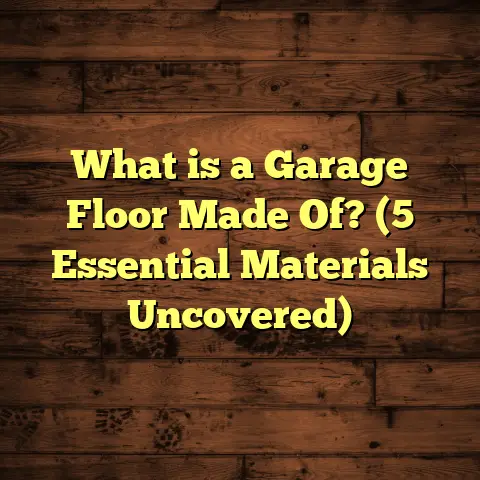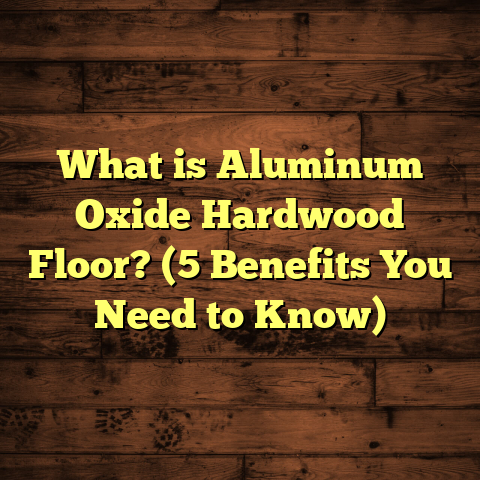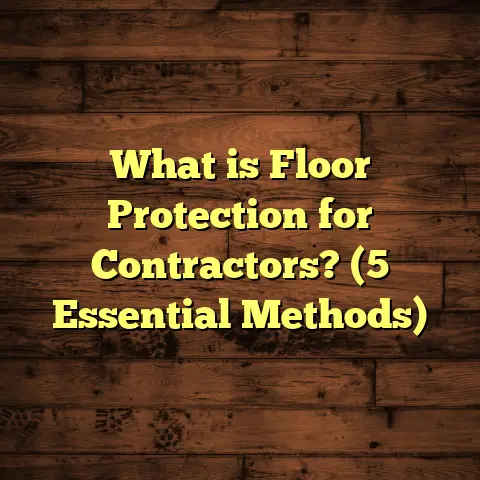What is Better: Prefinished or Unfinished Hardwood Floors? (5 Key Factors for Your Home)
Craftsmanship is a beautiful thing. When I watch a skilled artisan at work—whether they’re carving wood, shaping metal, or laying down hardwood floors—there’s a sense of pride and precision that goes beyond the surface. Flooring, in particular, has always fascinated me because it’s where artistry meets practicality in a home. The way hardwood floors can transform a space is incredible, but choosing between prefinished and unfinished hardwood floors? That’s where things get interesting and sometimes tricky.
If you’re like many homeowners I’ve worked with over the years, you probably have questions swirling around in your head: What’s the difference between prefinished and unfinished hardwood flooring? Which one is better for my home? How do these choices affect the installation process, look, durability, and budget? And what about maintenance and indoor air quality? Well, I’ve been on countless job sites, seen all kinds of floors installed, refinished, and maintained. Let me guide you through these questions with real examples, data, and insights from my experience.
What Is Prefinished and Unfinished Hardwood Flooring?
Let’s start by defining the two options clearly.
Prefinished hardwood floors are planks that come from the factory already sanded smooth, stained in a chosen color, and sealed with multiple coats of finish. This finishing process typically involves applying durable polyurethane coats that are cured using heat or UV light to harden the surface. Because this all happens under controlled factory conditions, the finish is very consistent and tough.
When you get prefinished hardwood flooring delivered to your home, the installer’s job is mostly to lay down the planks according to the pattern and secure them. There’s no need for sanding or finishing once installed. You can walk on prefinished floors almost immediately after installation.
On the flip side, unfinished hardwood floors come as raw wood planks without any finish applied. These planks are installed first, then sanded smooth on site. After sanding, you apply stain (if you want color), followed by multiple coats of finish like polyurethane or oil-based sealers directly on the floor. This finishing step happens inside your home after installation.
The finishing can be tailored to give you exactly the look and feel you want—a deep, rich stain or a light natural finish with matte or glossy sheen options. It requires more time because each coat has to dry thoroughly before the next is applied.
Why Does This Matter?
The choice between prefinished and unfinished isn’t just about aesthetics or cost—it fundamentally changes how your flooring project moves forward. It also influences long-term durability and maintenance options.
Over my years working in this field, I’ve seen homeowners make decisions based on price alone only to regret it later. Others have chosen based on looks but were unprepared for the mess and downtime during finishing.
I want to share what I’ve learned so you can avoid common pitfalls. Let’s dig into five key factors that will help you decide what’s better for your home.
1. Installation Process and Time: How Much Work Are You Ready For?
Installation is often one of the most stressful parts of any renovation. From my experience, this is where prefinished flooring really shines.
Prefinished Hardwood Flooring Installation
Since prefinished planks arrive ready to use, installation involves laying out and securing the boards. There’s no sanding or finishing needed on site. You’ll usually see workers fitting planks using glue-down methods, nail-down techniques, or floating floor installations depending on type and subfloor.
The process is relatively fast—most rooms under 500 square feet can be completed in a day or two by a professional crew.
Because the finish is factory-applied and cured, there’s no waiting for drying or off-gassing odors. This means you can use the room almost immediately after installation.
Unfinished Hardwood Flooring Installation
Unfinished floors require a multi-step process:
- First, install the raw hardwood planks.
- Next comes sanding with progressively finer grit sandpaper to smooth joints and prepare surfaces.
- Then apply stain if desired.
- Follow up with several coats of finish applied evenly.
- Each finish coat needs drying time—often several hours to overnight.
- Finally, after the last coat dries, floors may need buffing or additional sealing.
This process can take anywhere from 4 to 10 days or more for an average-sized room depending on drying conditions and number of finish coats.
Real-World Impact on Time
One of my clients wanted unfinished hardwood in their living room but underestimated how long finishing would take. They had to stay out of their home for almost two weeks due to dust from sanding and strong fumes from finishes.
In contrast, another client who went with prefinished floors was able to move back in immediately and didn’t have to deal with dust or odors.
Installation Cost Differences
Because finishing takes time and labor onsite, unfinished hardwood installation costs run higher on average—typically 25-40% more than prefinished flooring installation.
If you’re tight on schedule or want minimal disruption during remodeling, prefinished hardwood floors generally save time and hassle.
2. Appearance and Customization: How Much Control Do You Want Over Your Floor’s Look?
Appearance is often at the top of homeowner priorities when choosing hardwood floors. But here’s what I’ve noticed over years of project work: appearance isn’t just about color—it’s about texture, sheen, uniformity, and how well your floors fit your home’s style.
Prefinished Hardwood Floors: Consistency and Convenience
Prefinished floors come in tons of colors and finishes—from light natural tones to dark espresso browns—and various sheens like matte, satin, semi-gloss, and high gloss.
Because each plank is finished in a factory setting with automated equipment and quality controls, color is consistent from board to board. This means your floor will have a uniform look without blotches or streaks that sometimes happen with site finishing.
Also, many manufacturers offer special surface textures such as hand-scraped or wire-brushed finishes that give character without extra work onsite.
Unfinished Hardwood Floors: Total Customization
With unfinished hardwood floors, you start with raw wood and have total control over staining color intensity and finish sheen. Want a custom mix of stains or a unique color blend? You can do it here.
You can also choose natural oil finishes which penetrate wood rather than sitting on top like polyurethane. Oils bring out grain patterns beautifully but require more care.
Custom textures like distressing or hand-scraping are easier to apply onsite with unfinished wood since you have access to raw material before finishing.
Story from My Own Work
I did a project for a client restoring an early 1900s farmhouse who wanted their floors to match original wood in adjacent rooms perfectly. Since prefinished options didn’t match the exact stain tone or wood species (heart pine), we went with unfinished flooring.
That allowed us to recreate the look precisely with custom stains applied onsite. The result was stunning—authenticity was preserved perfectly because we controlled every detail during finishing.
Statistical Snapshot
A survey by the National Wood Flooring Association found:
- 70% of homeowners who chose unfinished hardwood prioritized customization.
- 85% of those opting for prefinished cited convenience as their main reason.
3. Durability and Maintenance: Which Flooring Holds Up Best Over Time?
Durability is often overlooked until damage appears. I’ve seen floors scratched by pets’ nails, dented by furniture legs, faded by sunlight—and knowing which type holds up best matters for long-term satisfaction.
Factory Finish Toughness
Prefinished floors get multiple coats of factory-cured polyurethane finishes using advanced processes like UV curing or electron beam curing. This results in a surface that’s harder than most site-applied finishes.
Many brands boast finishes rated at 2-3 times harder than traditional oil-based polyurethanes applied onsite.
This means better scratch resistance right out of the gate and less chance of wear in high-traffic areas during early years.
Unfinished Floors: More Refinishing Cycles
While site-applied finishes might not be as hard initially, unfinished solid wood floors often have thicker wear layers (6-8 mm) compared to prefinished (2-4 mm).
This thicker layer lets you sand down deeper multiple times—sometimes up to 5-7 times over a floor’s lifetime—restoring original beauty repeatedly without replacing boards.
Prefinished floors usually allow only 1-2 light sanding/finish recoats before reaching the wear layer limit.
Maintenance Tips I Share Often
- For prefinished floors: Use area rugs in heavy-use spots; clean spills promptly; avoid harsh chemicals.
- For unfinished floors: Regular cleaning plus periodic re-oiling or refinishing keeps them fresh longer.
Case Example
A commercial space I worked on chose prefinished flooring due to heavy foot traffic. After 5 years of use with minimal maintenance, scratches were superficial due to tough factory finish.
In a residential project with unfinished oak floors aged 10+ years, refinishing brought them back looking brand new multiple times—something not possible with thinner prefinished wear layers.
4. Cost Implications: How Does Your Budget Affect Your Choice?
I get asked about cost dozens of times each week by homeowners trying to balance dreams with reality.
Material Cost Differences
Raw unfinished hardwood planks tend to cost slightly less per square foot than prefinished because you’re buying wood without added finishing labor included.
However:
- Prefinished flooring includes factory sanding, staining, sealing costs built into price.
- Unfinished requires budgeting for stains, sealers, tools, ventilation plus labor for sanding/finishing onsite.
Labor Costs
Labor is where unfinished floors get expensive quickly:
- Sanding takes hours per room.
- Multiple finish coats require drying time.
- Additional cleanup needed for dust and fumes.
Prefinished installation pays less labor because it skips these steps entirely.
Typical Price Ranges
From projects spanning low-budget remodels to high-end homes:
| Flooring Type | Material Cost (per sq ft) | Installation Cost (per sq ft) | Total Average Cost (per sq ft) |
|---|---|---|---|
| Prefinished Hardwood | $5 – $10 | $3 – $5 | $8 – $12 |
| Unfinished Hardwood | $4 – $8 | $6 – $9 | $10 – $15 |
Hidden Costs
Don’t forget:
- Unfinished floors need proper ventilation during finishing—rental fans or air purifiers add cost.
- Potential lost use of rooms during drying time.
One family I worked with didn’t anticipate renting an HVAC system for VOC control during an unfinished floor project—this added nearly $1,000 unexpectedly.
5. Indoor Air Quality & Environmental Concerns: What Are You Breathing?
People rarely think about air quality until they experience headaches or allergies post-renovation.
VOCs in Flooring
Volatile organic compounds (VOCs) come from solvents in stains and finishes that evaporate into the air during drying.
Since prefinished floors are finished off-site under controlled conditions:
- They emit very low VOCs after installation.
- No strong odors linger post-installation.
Unfinished floors finished onsite:
- Release VOCs into living spaces during stain/finish application.
- Can cause strong odors lasting days or weeks.
- May trigger allergies or respiratory issues in sensitive individuals.
Certifications Matter
Many prefinished flooring products carry certifications like Greenguard Gold or FloorScore, which test for low emissions ensuring healthier indoor air quality.
Unfinished flooring’s impact depends heavily on choice of stain/finish products used onsite—low-VOC options exist but cost more and require careful application.
Personal Story
One client had a toddler with asthma; they tried unfinished floors first but had severe breathing issues during finishing week. We switched to low-VOC stains but ultimately recommended prefinished flooring for their next project to avoid future risks altogether.
Additional Considerations Based on My Experience
While these five factors cover most bases, I want to share some other insights I’ve gained through years in this trade:
Flooring Species Compatibility
Some wood species respond better to factory finishing due to grain density or natural oils that interact poorly with site-applied finishes. For example:
- Maple tends to blotch when stained onsite unless properly conditioned.
- Hickory’s natural color variations often benefit from customized onsite stain work for best look but can be found in decent factory finishes too.
If you pick an exotic species like Brazilian cherry or tigerwood, check if prefinished options exist at your preferred quality level before deciding.
Subfloor Conditions Matter
Prefinished floors require flat subfloors since they aren’t sanded after installation. Any unevenness shows through visually and can cause squeaks or gaps over time.
Unfinished floors allow some sanding correction post-installation which helps smooth minor subfloor irregularities before finishing coats are applied.
Repairability & Spot Fixing
If a small section gets damaged:
- Prefinished floors can be tricky since matching factory finish exactly is difficult.
- Unfinished floors allow seamless refinishing over repaired areas onsite blending finish perfectly.
Putting It All Together: My Personal Take
After installing thousands of square feet across dozens of projects—and seeing how different clients’ needs shaped their choices—I’ve come to appreciate that neither prefinished nor unfinished hardwood floors are inherently “better.” It depends on your situation:
| Factor | Prefinished Hardwood Floors | Unfinished Hardwood Floors |
|---|---|---|
| Installation Speed | Faster; walkable immediately | Longer; days for sanding & finishing |
| Customization Options | Limited colors/textures available | Full control over stain & finish |
| Durability | Harder factory finish; fewer refinishes | Thicker wear layer; more refinishing cycles |
| Cost | Lower labor costs; faster install | Higher labor costs; longer process |
| Indoor Air Quality | Low VOC emissions; minimal odors | Higher VOCs from onsite finishing |
I recommend prefinished hardwood if you want quick installation with less disruption,
and unfinished hardwood if you want ultimate control over appearance with patience for longer process times.
Frequently Asked Questions from My Clients
Q: Can I refinish prefinished hardwood floors?
Yes—but only lightly. Prefinished floors typically allow 1–2 light sanding and recoating cycles before the wear layer becomes too thin. Heavy refinishing isn’t recommended without replacing boards.
Q: Are unfinished floors more prone to damage during installation?
They can be because raw wood isn’t protected until finished onsite. Careful handling during install is essential to avoid dents or scratches before finishing coats are applied.
Q: Which option is better for radiant heated floors?
Most engineered prefinished hardwoods work well over radiant heat systems because they have stable plywood cores minimizing expansion/contraction. Solid unfinished wood can work too but requires careful acclimation and installation techniques.
Final Thoughts From Working Hands
Choosing between prefinished and unfinished hardwood flooring boils down to what matters most for your lifestyle:
- Need quick install & minimal mess? Prefinished.
- Want custom colors & maximum refinishing? Unfinished.
- Concerned about indoor air quality? Prefinished wins.
- Budget tight but want authentic hardwood? Prefinished often saves money overall.
Both types bring warmth and character that no other flooring matches. With these five factors considered carefully,
you’ll feel confident making a choice that fits your home perfectly—not just today but for years ahead.
If you want me to help crunch numbers based on your room sizes or walk through specific product recommendations,
just ask! I’m here anytime you need advice grounded in real-world experience.





